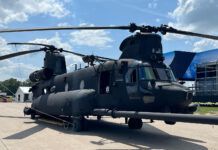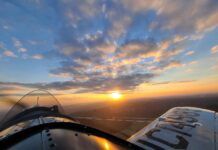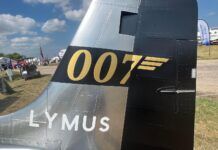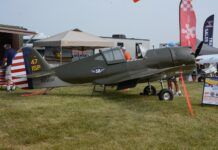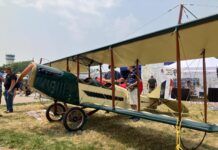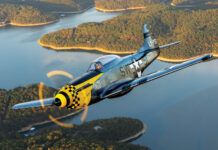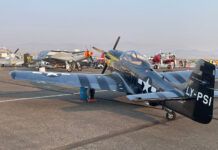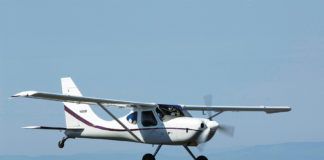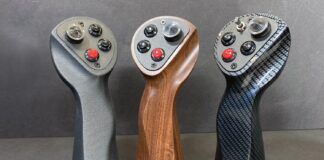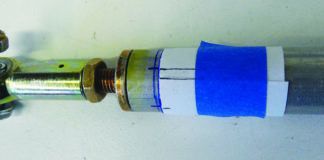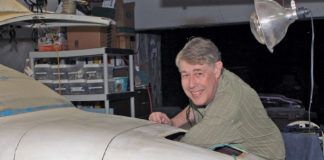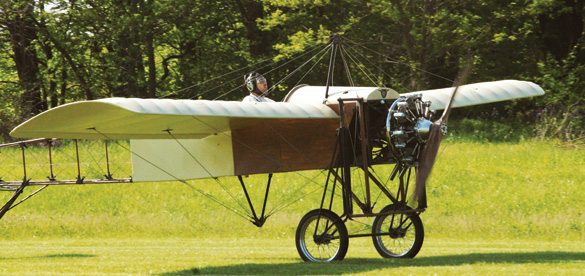
“There is no possible way that thing flew on a 25-horsepower engine.” The rest of The Dawn Patrol looked on silently in amazement. No way. I looked at the plane in disbelief. The full-scale Bleriot XI was just plain BIG.
This was the one I wrote about last June, after I fell in lust with the new Airdrome Aeroplanes DH-2 replica. At the time, Robert (Bullwhip) Baslee and Pascal Kremer were finishing up the full-scale Bleriot replica that Kremer planned to fly across the English Channel on July 25, 2009. It would be 100 years to the day from the first flight across the barrier that had kept England safe from most intruders for centuries.
In 1909, Louis Bleriot’s 37-minute flight ranked right up there with some of the world’s greatest achievements. It sent shock waves around the globe. It also sent shock waves through the British military. The indomitable British Navy couldn’t do much about an enemy in the air.
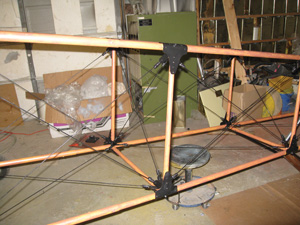
After the painting and wood-graining, you’ve got to look closely to make sure it’s not really wood.
What made it more amazing was that not only did this plane fly on a tiny 25-hp engine, but the longest flight Bleriot had ever made up to that time was a little over 50 minutes. He was trying to win a $5000 prize for being the first plane to fly the English Channel, and that was a pretty scary deal at the time. One pilot, Hubert Latham, had already tried to fly the Channel in his Antoinette airplane. His engine failed when he was halfway across, and he ditched in the water. That his engine failed was not surprising. The aircraft engines available back then were prone to overheating and a plethora of other mechanical illnesses. It was rare for an engine to run longer than 20 minutes. In fact, some historians say that if Bleriot had not flown through some rain showers that cooled the little Anzani engine, he would have ended up in the drink as well.
Even though Bleriot had already won the prize, Latham still wanted to prove that he could make the flight. On July 27, he again attempted the flight, and when the engine failed, back into the channel he went.
Anyway, that’s history. Bleriot did it. He got the money, and his place in history was assured. Shortly after that Channel flight, Bleriot went into aeronautical design and engineering. He became president of the aircraft company Société pour les Appareils Deperdussin in 1914, renaming the company Société Pour Aviation et ses Derives (SPAD) and turning it into one of France’s leading builders of combat aircraft. During WW-I, SPAD manufactured more than 5600 aircraft for France and other countries. But, again, that was history. This was now!
Building the Bleriot
The plane that Kremer contracted with Robert Baslee to build using Baslee’s builder-assistance program was going to be as close to the original dimensions as they could make it. They did it, too. There’s no place on that plane that’s more than a quarter-inch off from the original drawings.
Kremer had searched all over Europe for Bleriots in museums and had come equipped with hundreds of photographs of real Bleriot XIs along with many copies of original drawings.
My wife, Sharon, and I were pawing the ground waiting for the Bleriot to get finished so that we could start on the DH-2. We made several road trips with The Dawn Patrol to Baslee’s Airdrome Aeroplanes plant to check on the progress of the “Channel Challenger.” This was in January, the worst time of year in northern Missouri. Everything is frozen solid. Well, they finished the Bleriot. You can almost see what’s coming, can’t you? Yep. We got a call from Baslee the next day. He told us to report to the “House of Pain” ready to start work on the DH. (That’s another story.)
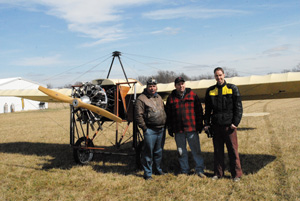
After they’d warmed up in the airport office and had the PIREP. Eric Presten (left), Robert Baslee and Harvey Cleveland pose in front of the Channel Challenger.
Winter Woes
When we built Sharon’s Morane Saulnier “L” Parasol at Baslee’s facility, it was summer. The shop doors were open, and the balmy summer winds blew through the shop. It was a real nice experience. But a fun-filled day in Bullwhip’s shop in winter is a shock to the system. The shop is unheated. He doesn’t like it heated. He doesn’t want it heated. In Bullwhip’s opinion, if you can barely see your breath in the shop, the temperature is just right. If you are foolhardy enough to complain, he says you’re not working hard enough to keep warm. Baslee does have a little kerosene burning “torpedo” that he might turn on when the water in the washing bucket freezes. But the operative word here is might. If you can break the ice with your fist, it’s still not that cold. On the rare events when Bullwhip had to go to the house to get some documents or answer emails, we’d sneak over, turn the torpedo on, and just stand and shiver in the blast of super-heated air. One side of your body would be blistering red and the other side shivering blue. So on average, you were actually pretty darn comfortable.
The downside was that the torpedo sounded like a 747 taking off, so when Bullwhip came out of the house, he’d hear the thing blasting away. Then we’d hear him bellow, “TURN THAT DANG THING OFF!” Sigh. Back we went to shivering in the deep freeze.
Let me tell you, working with a parka on while wearing mittens is a new and wonderful experience. I might add that while we were all slowly turning blue, Bullwhip was flitting gaily around the shop wearing only a long-sleeved shirt. (We all secretly think he’s some kind of alien being from a very cold planet called Brass Monkey.) But on the plus side, you do learn to work fast.
Back to Pascal Kremer. He flies for a European airline, so he arranged for his breaks to space out so that he could come over and spend a week or so at the House of Pain working on the plane.
The Dawn Patrol visited there several times to help out by drilling holes, pulling rivets and joining in on some of the head-scratching moments. In a few memorable instances, we brought progress to a standstill.
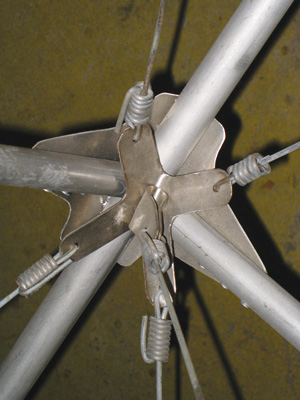
Wire bracing details, just like they did it in 1909. It is a lot simpler than it looks.
This replica is so close to the original that from 20 feet away, you can’t tell it’s made from tube-and-gusset aluminum construction. All of the fuselage members and side panels are painted with woodgrain effect. It looks real. The way they did the internal fuselage wire bracing is a wonderment. Baslee whipped up a fixture in one of his lathes that coiled the wire just like they did in 1909.
He called us up after the plane had been inspected and asked if we’d like to see the maiden flight. Another no-brainer for us. The Dawn Patrol loaded up the stealth van, and we thundered off to a wonderful little 3000-foot grass strip about 4 miles west of Warrensburg, Missouri (home of the B-2 bombers).
The one really big difference between this replica and the original is the powerplant. The tiny 25-hp Anzani was replaced by a big, snarly Rotec radial engine up front. We arrived at the field just as they were getting the plane ready to go. In my opinion, it was a horrible day to fly. The blustery wind was a 90° cross at 15 mph with gusts to 20. The temperature was a bone-chilling 19°. I normally wouldn’t even open the hangar doors on windy days like this. Factor in the temperature, and I wouldn’t even be at the airport.
First Flight Fans
In this case, Baslee had called upon two of his most trusted test pilots: Harvey Cleveland and Eric Presten. They have flown all of his designs. They test-flew the four full-scale Nieuport 17s that Baslee had built for the movie Flyboys. Presten went with Baslee to England for the filming, and he also test-flew all of Baslee’s Nieuport replicas after they were reassembled to check them for trim. Flying in weather like this was just a normal day at the office for these two intrepid pilots.
I’ve already talked about Cleveland. He has almost every rating known to man and has accumulated 23,000 hours in the air. More than 20,000 of those hours are in single-engine aircraft.
Cleveland won the coin toss for the first flight, so he mounted up and strapped himself in the cockpit. Then we pulled the monstrous 84×43 Culver prop through seven blades to check for any hydraulic lock. All was well, so Cleveland fired up the big R-2800 engine. It purred like a really big, hungry kitten. He let it idle for about 5 minutes until every needle had found a green arc.
When all was well, he taxied the plane to the end of the 3000-foot runway. After a quick control check, he did a fast taxi down the field to check for directional control and feel out the whole setup. He turned around at the far end, and as he came back past us, we got a thumbs up.
Now it was time to aviate. We heard the engine spool up. After a very short run, the plane lifted off as nice as you please. Cleveland spent about 10 minutes checking out the controls and then made a pass down the runway with his arms in the air. Wow! Hands-off trim on the first flight! When he lined up for the landing, we were all amazed that he didn’t seem to have to drop the wing to adjust for the crosswind. The landing was a non-event.
Cleveland’s PIREP was short and sweet. Well…actually, first he had to stop shuddering and stuttering from the cold. It took about 5 minutes before we could finally understand him when he said, “Flies great. Power out the wazoo. And the open framework on the fuselage lets the wind blow right through. The crosswind was nothing to worry about.” He was right, too. The Champ that had come in to do some air-to-air photo work had a much worse time making its landings.
Then it was Presten’s turn. His flight went just as well. In fact, everything went much better than expected. There was no tweaking needed. There was a long PIREP meeting in the heated airport office, and every aspect of the flights was discussed and analyzed. Both of the pilots agreed that it was one impressive aircraft. They both want one.
Cleveland made several more flights for some air-to-air photo work with the Champ. They’d go up, make some circuits around the field and land. Then they’d look at the photos and plan the next photo flight to get different angles and perspectives. Each time, the Bleriot’s landing was a non-event. The Champ had a lot more trouble with the gusty crosswind.
Cleveland was feeling good about the plane, so he started doing some maximum effort climbouts. Man, can that thing go upstairs. The climb angle was so steep that when he was climbing out from takeoff, heading away from us, we could see the entire top of the plane. When he came down, he said he couldn’t see the horizon on climbout because it was hidden below the leading edge of the wing. That’s steep! That big under-cambered airfoil is really something!
We’d learned all we needed to know. This plane was a keeper. The Channel flight should be a piece of cake. Now it was time to take the plane apart, put it on the trailer and get ready for the trip to Sun ’n Fun. While he was at the show, Kremer was presented with the Best Plansbuilt award for the Bleriot. Then it was back to Baslee’s field so he could start working off the 40 hours.
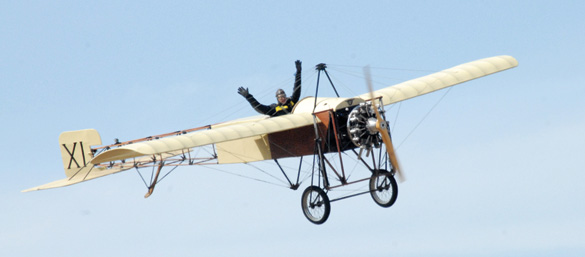
Cleveland makes a low pass with his arms in the air to show how well the plane flies hands-off.
Spring has finally sprung, and we have been blessed with a series of perfect flying days. As I write this, Cleveland and Kremer are flying the Bleriot every chance they get, taking turns putting hours on the plane. So far, nothing has shown up that needs work. Once the hours are flown off, the plane will be carefully packed in a shipping container for transfer to the East Coast. There it will be placed on a container ship for its trip to Calais, France. If all goes well, Kremer will make the same trip that Louis Bleriot made 100 years ago on that date. I would love to be there for his landing in England.
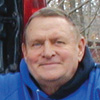
![]()
Dick Starks has written two books about the joy of flying; “You Want To Build And Fly A What?” and “Fokkers At Six O’clock!!” He was the recipient of Flying’s 2001 Bax Seat Award “for perpetuating the Gordon Baxter tradition of communicating the excitement and romance of flight.” Dick and his wife, Sharon, both fly WW-I replica aircraft.


